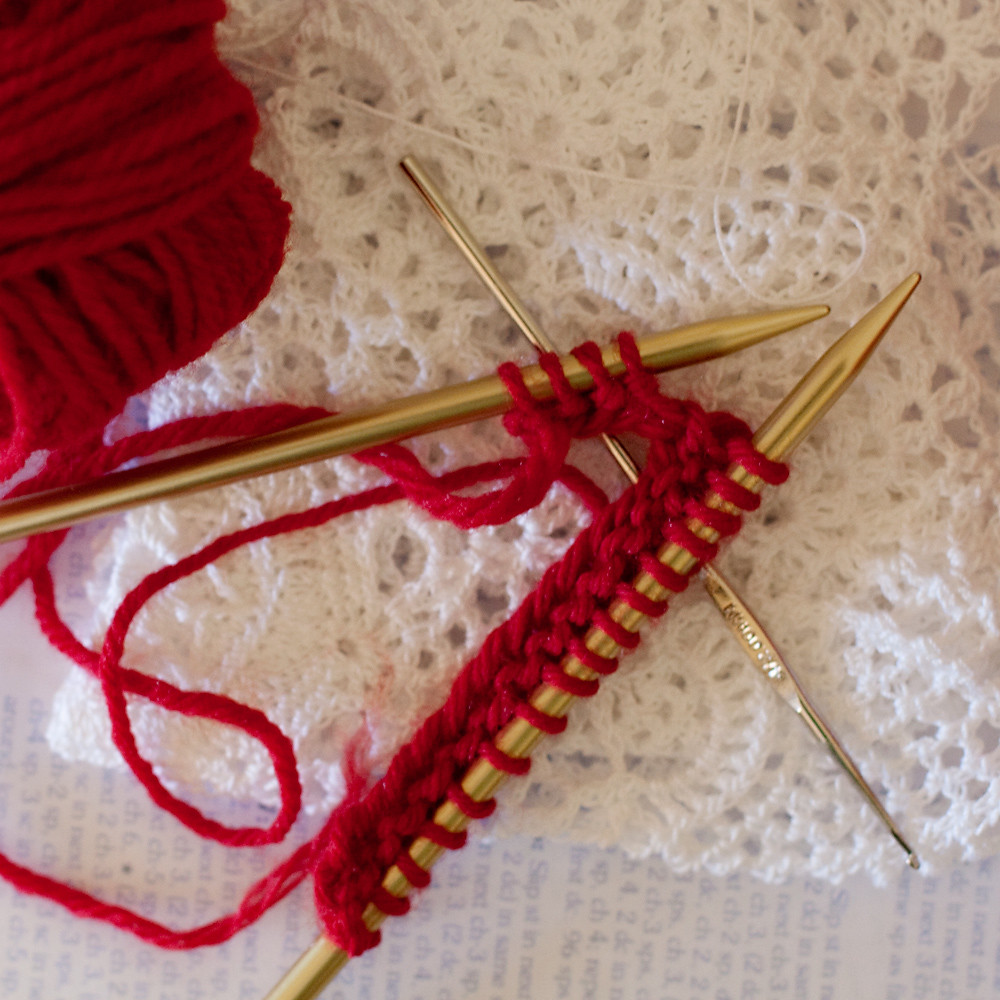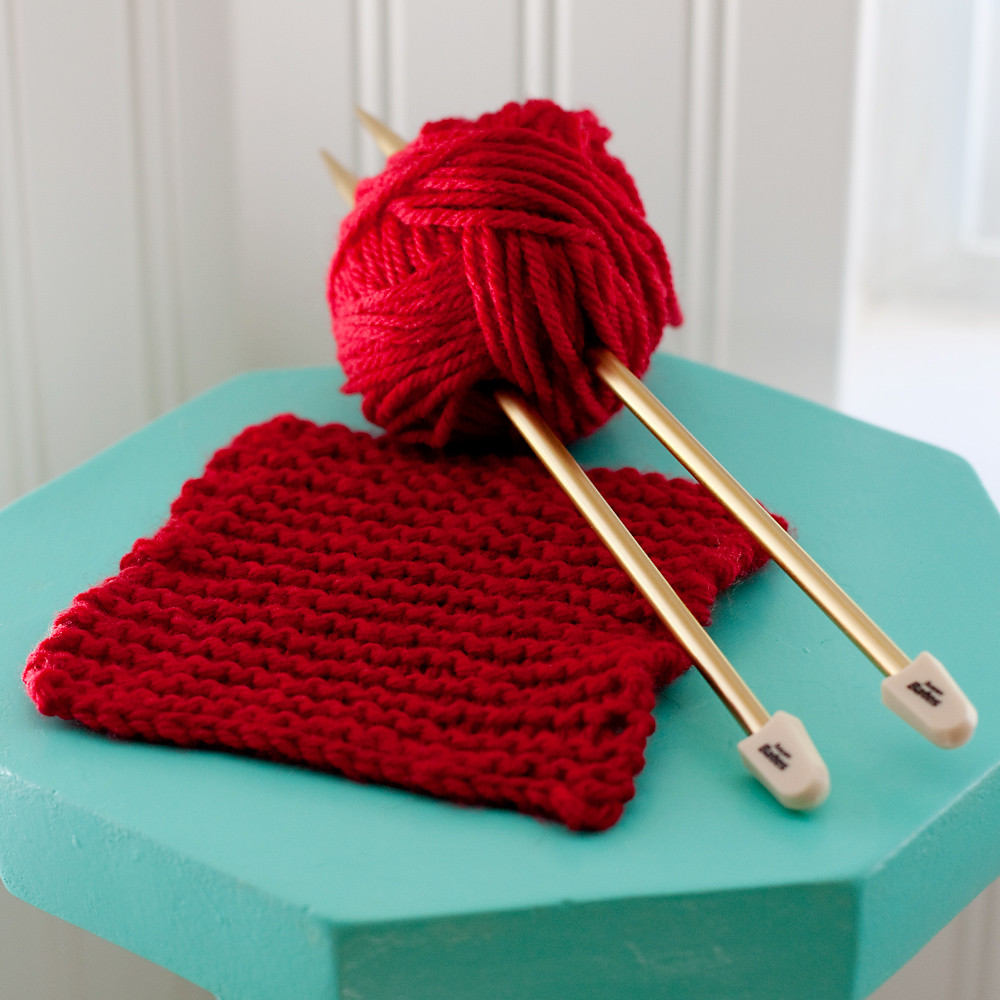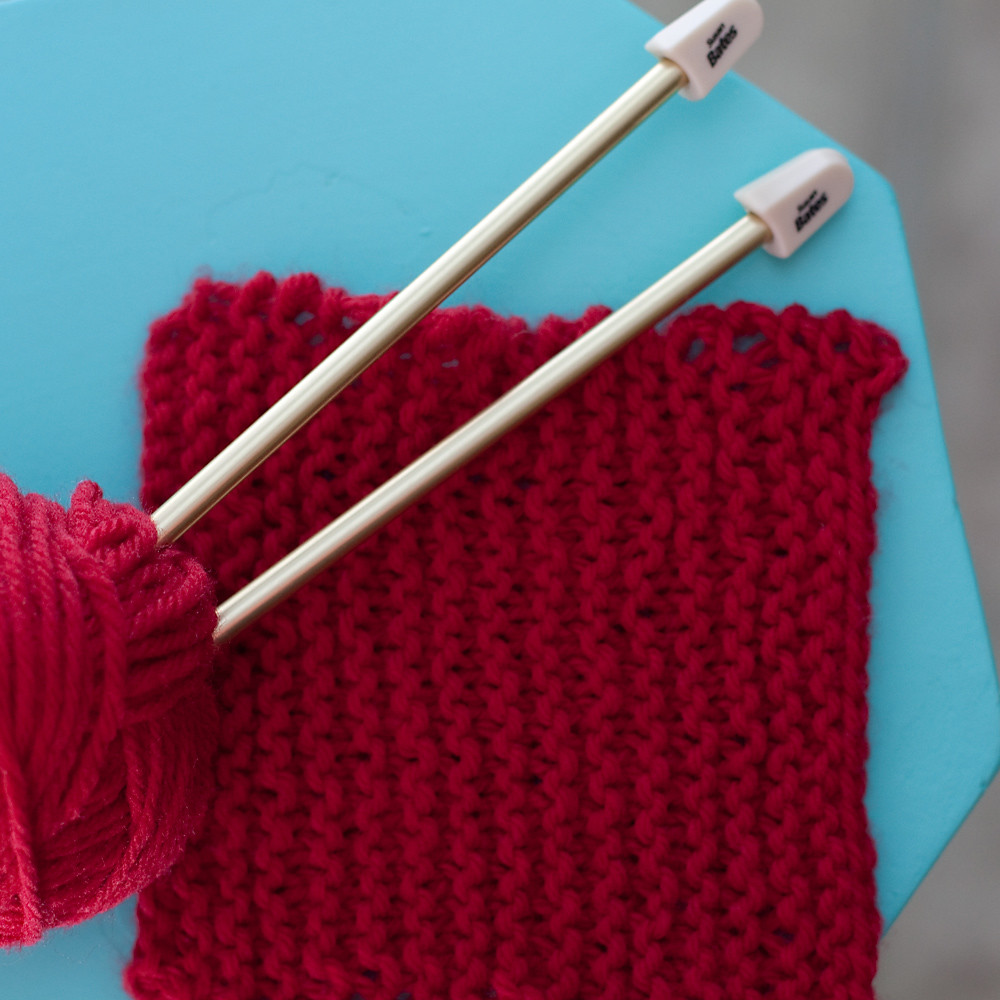What's this?
Knitting needles?! Shocking, isn't it? ;o)
For a while, I resisted all thoughts of learning to knit-- at least partly out of loyalty to crochet. I liked the looks of both, but I felt that crochet often got short shrift. Poor thing. Plus, everyone always comments on how fast crochet is compared to knitting. (Not a selling point for knitting, honestly.) Also, how long would it take me to learn a whole new craft? Why bother, when I already knew how to crochet? Despite those concerns, I eventually decided that, ok, I would like to know how to do both, mainly because it would open up a whole new collection of free patterns-- and because I'd fallen in love with knitted lace shawls. (There are some lovely crocheted shawls, too, but they're not quite the same thing.)
I tried to teach myself to knit a year or so ago (or who knows how long ago, the way the months zip by). It was not a success. At all. However, this time around, I am determined to stick with it and learn. It may take a while, but I know it's possible-- and even after only a few rows of a (very, very simple) dishcloth (i.e. a square of garter stitch), it already felt much easier to do than when I first picked up the needles. True, I wielded those needles awkwardly, and I had a feeling that watching my laborious progress would cause a skilled knitter actual physical pain and nervous twitches... but I persevered.
The funny part (to me, at least) was how easy the cast-on was compared to the actual knitting. Maybe that's the way it always is for everyone, but I would've thought casting-on would be trickier. It did take me a few minutes to understand where to put the needle in relation to the yarn, but once I got that sorted, I was zooming along, if I do say so myself. It was the same the last time I tried to learn. So, knitting at first seems harder than casting-on. Maybe this is because knitting requires the use of two needles, whereas the cast-on is done with one needle-- somewhat similar to crochet. Actually, this time around, I'm already seeing that (for me, at this point in my infant knitting career) you actually don't have to think much about both needles at the same time. What a relief! It feels easier if I only have to really think about one needle at a time.
Comparing crocheting to knitting reminds me of playing melodies vs. harmonies. I can play clarinet and a little flute-- and I can tap out a melody on a piano/keyboard. Anything where you only play one note at a time is easy enough-- especially if I'm playing by ear. (I've long since forgotten how to read music. I suspect it would come back with a little practice, but I was never that good at sight reading.) The thought of "really" playing the piano, though-- of almost constantly hitting multiple keys at the same time-- throws my poor brain for a loop. Crochet-- only one hook to focus on at a time-- has long seemed less complicated to me than the double needles of knitting. But now that I can think of it as one needle sitting still-- just holding the loops and project-- while the other needle does all the "work"... it's much less intimidating. I suspect that an experienced knitter moves both needles simultaneously and thinks of them as working together to accomplish each stitch. Maybe someday I'll manage it.
A couple more things I've found interesting, as a crocheter learning to knit:
1. Right-handed crocheters may find it easier to learn the Continental method of knitting. Using the Continental method (as opposed to the English method), you hold the yarn in your left hand, which of course is the same hand right-handed crocheters use to hold their yarn. I'm sure anyone can learn either method, but I'm happy to have one less unfamiliar thing to deal with as I embark on this new adventure. ;o)
2. The transition from hook to needle may be somewhat easier for crocheters who hold the crochet hook like a knife than those who hold it like a pencil, since the knife-hold is more common for knitting needles. I've always found it more comfortable to hold my hook knife-style, so switching to holding at least the right-hand needle has been pretty easy. (But again, there are multiple ways to hold both hooks and needles, I'm sure, and being a pencil-style crocheter shouldn't discourage you from learning to knit.)
Are you read for the big reveal? ;o)
Here's my first completed knitted project:
It's not perfect or even very pretty, but I knitted it all by myself!
I've since knitted my second mini dishcloth, too. This time, I tried a pattern identical to this one: Grandma's Favorite. (It was in a freebie PDF about learning to knit.) It looked like a good way to learn to increase, decrease, and "yarn over", but honestly, I didn't enjoy my second project as much as the first one. I think I may need to take it slowly until I learn how to fix the little boo-boos that pop up in a newbie's knitting.
You know what they say about practice making perfect. I think I have a lot of practice ahead of me before I'll be ready to tackle one of those intricate laceweight shawls, but it shouldn't be long before I'm ready for something like this: One Row Lace Scarf. (Technically, I think I could follow that pattern even now, but I'd rather wait until I'm a little more comfortable with the needles... My technique needs work.)
So... more swatches / dishcloths? I figure the dishes won't care what the dishcloth looks like, so long as it gets the job done. ;o)
Knitting needles?! Shocking, isn't it? ;o)
For a while, I resisted all thoughts of learning to knit-- at least partly out of loyalty to crochet. I liked the looks of both, but I felt that crochet often got short shrift. Poor thing. Plus, everyone always comments on how fast crochet is compared to knitting. (Not a selling point for knitting, honestly.) Also, how long would it take me to learn a whole new craft? Why bother, when I already knew how to crochet? Despite those concerns, I eventually decided that, ok, I would like to know how to do both, mainly because it would open up a whole new collection of free patterns-- and because I'd fallen in love with knitted lace shawls. (There are some lovely crocheted shawls, too, but they're not quite the same thing.)
I tried to teach myself to knit a year or so ago (or who knows how long ago, the way the months zip by). It was not a success. At all. However, this time around, I am determined to stick with it and learn. It may take a while, but I know it's possible-- and even after only a few rows of a (very, very simple) dishcloth (i.e. a square of garter stitch), it already felt much easier to do than when I first picked up the needles. True, I wielded those needles awkwardly, and I had a feeling that watching my laborious progress would cause a skilled knitter actual physical pain and nervous twitches... but I persevered.
The funny part (to me, at least) was how easy the cast-on was compared to the actual knitting. Maybe that's the way it always is for everyone, but I would've thought casting-on would be trickier. It did take me a few minutes to understand where to put the needle in relation to the yarn, but once I got that sorted, I was zooming along, if I do say so myself. It was the same the last time I tried to learn. So, knitting at first seems harder than casting-on. Maybe this is because knitting requires the use of two needles, whereas the cast-on is done with one needle-- somewhat similar to crochet. Actually, this time around, I'm already seeing that (for me, at this point in my infant knitting career) you actually don't have to think much about both needles at the same time. What a relief! It feels easier if I only have to really think about one needle at a time.
Comparing crocheting to knitting reminds me of playing melodies vs. harmonies. I can play clarinet and a little flute-- and I can tap out a melody on a piano/keyboard. Anything where you only play one note at a time is easy enough-- especially if I'm playing by ear. (I've long since forgotten how to read music. I suspect it would come back with a little practice, but I was never that good at sight reading.) The thought of "really" playing the piano, though-- of almost constantly hitting multiple keys at the same time-- throws my poor brain for a loop. Crochet-- only one hook to focus on at a time-- has long seemed less complicated to me than the double needles of knitting. But now that I can think of it as one needle sitting still-- just holding the loops and project-- while the other needle does all the "work"... it's much less intimidating. I suspect that an experienced knitter moves both needles simultaneously and thinks of them as working together to accomplish each stitch. Maybe someday I'll manage it.
A couple more things I've found interesting, as a crocheter learning to knit:
1. Right-handed crocheters may find it easier to learn the Continental method of knitting. Using the Continental method (as opposed to the English method), you hold the yarn in your left hand, which of course is the same hand right-handed crocheters use to hold their yarn. I'm sure anyone can learn either method, but I'm happy to have one less unfamiliar thing to deal with as I embark on this new adventure. ;o)
2. The transition from hook to needle may be somewhat easier for crocheters who hold the crochet hook like a knife than those who hold it like a pencil, since the knife-hold is more common for knitting needles. I've always found it more comfortable to hold my hook knife-style, so switching to holding at least the right-hand needle has been pretty easy. (But again, there are multiple ways to hold both hooks and needles, I'm sure, and being a pencil-style crocheter shouldn't discourage you from learning to knit.)
. . . . . . .
Are you read for the big reveal? ;o)
Here's my first completed knitted project:
It's not perfect or even very pretty, but I knitted it all by myself!
I've since knitted my second mini dishcloth, too. This time, I tried a pattern identical to this one: Grandma's Favorite. (It was in a freebie PDF about learning to knit.) It looked like a good way to learn to increase, decrease, and "yarn over", but honestly, I didn't enjoy my second project as much as the first one. I think I may need to take it slowly until I learn how to fix the little boo-boos that pop up in a newbie's knitting.
You know what they say about practice making perfect. I think I have a lot of practice ahead of me before I'll be ready to tackle one of those intricate laceweight shawls, but it shouldn't be long before I'm ready for something like this: One Row Lace Scarf. (Technically, I think I could follow that pattern even now, but I'd rather wait until I'm a little more comfortable with the needles... My technique needs work.)
So... more swatches / dishcloths? I figure the dishes won't care what the dishcloth looks like, so long as it gets the job done. ;o)


